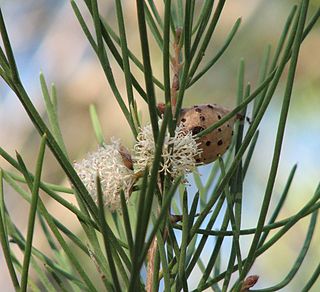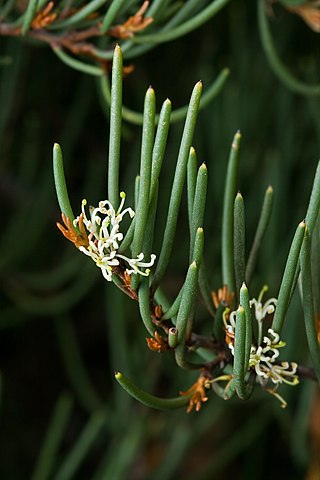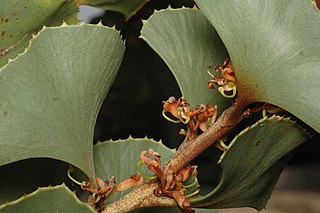
Hakea is a genus of about 150 species of flowering plants in the family Proteaceae, endemic to Australia. They are shrubs or small trees with leaves that are sometimes flat, otherwise circular in cross section in which case they are sometimes divided. The flowers are usually arranged in groups in leaf axils and resemble those of other genera, especially Grevillea. Hakeas have woody fruit which distinguishes them from grevilleas which have non-woody fruit which release the seeds as they mature. Hakeas are found in every state of Australia with the highest species diversity being found in the south west of Western Australia.

Hakea salicifolia, commonly known as the willow-leaved hakea, is a species of flowering plant that is endemic to eastern Australia. It is an adaptable, fast growing small tree or shrub with attractive foliage and cream white flowers.

Hakea petiolaris, commonly known as the sea-urchin hakea, is a shrub or small tree with cream-coloured and pink or purple flowers and woody fruit. It is endemic to the south west of Australia, occurring at the coastal plain, jarrah forest and wheatbelt regions, often at the ancient granite outcrops of Western Australia.

Hakea bakeriana is a shrub in the family Proteaceae. It is endemic to the Central Coast of New South Wales, Australia. It is a dense shrub with sharply pointed, cylinder-shaped leaves and pink to crimson flowers in groups of between four and twelve. The fruit is a rough, wrinkled follicle which terminates in a short beak.

Hakea drupacea, commonly known as sweet-scented hakea, is a tree or shrub which is native to south west Western Australia.

Hakea cygna, commonly known as the swan hakea, is a species of flowering plant in the family Proteaceae. It usually grows as a dense shrub with creamy-white upright flowers appearing from July to August. It is endemic to Western Australia.

Hakea decurrens, commonly known as bushy needlewood, is a species of shrub or small tree in the family Proteaceae.

Hakea epiglottis is a shrub commonly known as beaked hakea or needlebush hakea. It is endemic to Tasmania, where populations consist of functional unisexual plants. A 1989 publication by John Wrigley & Murray Fagg states that specimens at Wakehurst Place, an annexe of Kew Gardens London, are believed to be 60-70 years old measuring 3 m (9.8 ft) high and wide.

Hakea chordophylla, commonly known as bootlace oak, bootlace tree, corkwood, or bull oak, is a species of shrub or small tree in the family Proteaceae found in central and northern Australia. Bears very showy golden yellow, pale green or cream nectar rich flowers in winter.

Hakea commutata is a shrub in the family Proteaceae native to Western Australia. A variable species in shape and growing requirements, including mallee heath, sand and along creek lines.

Hakea aculeata, commonly known as the column hakea, is a vulnerable species of the family Proteaceae found in the Wheatbelt region of Western Australia. An unusual sculptural species with dense columns of prickly foliage and plentiful clusters of strongly scented blooms in spring.

Hakea leucoptera, commonly known as silver needlewood, needle hakea, pin bush or water tree and as booldoobah in the Koori language, is a shrub or small tree with rigid, cylindrical, sharply pointed leaves and white, cream-coloured or yellow flowers in late spring and early summer. It is widespread and common in central parts of the Australian mainland.

Hakea brownii commonly known fan-leaf hakea is a shrub in the family Proteaceae native to an area in the Wheatbelt region of Western Australia. This species shares a common name with Hakea baxteri due to its distinctive leaves.

a

Hakea cyclocarpa, commonly known as the ram's horn, wild bean or curved-fruit hakea is a shrub in the family Proteaceae. A strongly scented species with large creamy-white flowers with a red style and interesting fruit. Native to an area along the west coast and south west regions of Western Australia.

Hakea pendens is a flowering plant in the family Proteaceae and endemic to a small area in the Goldfields-Esperance regions of Western Australia. It is a small shrub with needle-like leaves and pendulous pink flowers.

Hakea recurva, commonly known as jarnockmert, is a flowering shrub or small tree in the family Proteaceae and is endemic to an area in the Mid West, northern Wheatbelt and the Goldfields-Esperance regions of Western Australia. It has creams-white to yellow flowers and thick, prickly, curved leaves.

Hakea stenophylla is a shrub or tree in the family Proteaceae, with sweetly scented creamy-white flowers. It is endemic to Western Australia.
Hakea leucoptera subsp. sericipes is a small tree with cylinder-shaped leaves and clusters of up to forty-five white fragrant flowers. It is found in northwestern New South Wales, Queensland and Western Australia.
Hakea recurva subsp. arida is a plant in the family Proteaceae endemic to the south-west of Western Australia.


















